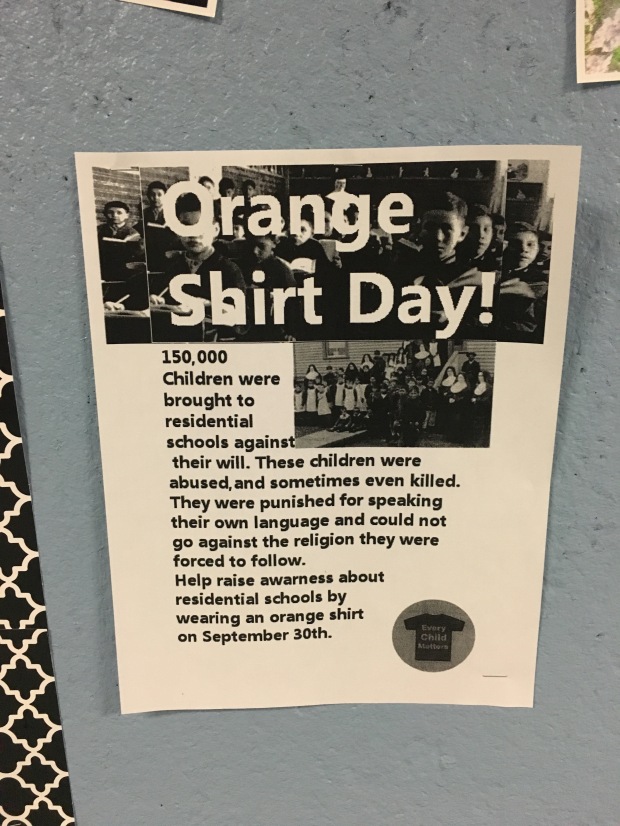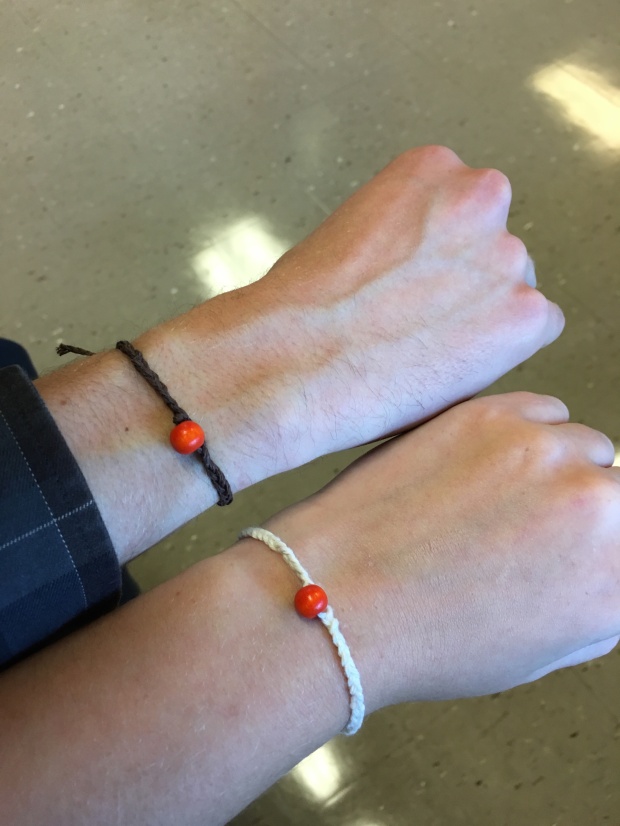Field trips are great at any level of schooling. They let you take what you’ve been learning and see how it applies in a real-world setting. Our trip to Trevor MacKenzie’s English classroom in Oak Bay High School was no exception to this; we’ve been discussing inquiry-based learning in our Education classes for about a month and a half now, but (other than the flex classes I’ve observed) haven’t really seen the practice in action at the high school level.
Trevor’s class is designed around inquiry. He has graphics on the walls to make the inquiry process clear to his students, and even the room itself, which has a transparent garage door that is always open, reflects his open approach to learning. Spending the afternoon discussing inquiry-based learning and asking questions about the logistics of implementing it really helped me wrap my head around how I might begin to develop a class with inquiry as its focus. By recording details of my time there, I hope to illuminate the process of creating an inquiry-based classroom for others. Graphics in this blog post are from Trevor’s book, Dive Into Inquiry.
Trevor explained his path to free inquiry as a scaffolded approach where he does a gradual release of responsibility. In the first quarter of the year, he designs topics and inquiries, bringing in resources that will help the class form an answer together. This year, his first inquiry is “what are stories and why are they important?” In the second quarter, he will begin to release some responsibility to his students, allowing them to have some control in the inquiry process. They are given even more responsibility in the third quarter, choosing an inquiry topic off a list and creating their own assessment piece. Finally, in the final quarter of the year, Trevor allows students to choose their own inquiry topic and their own assessment piece.
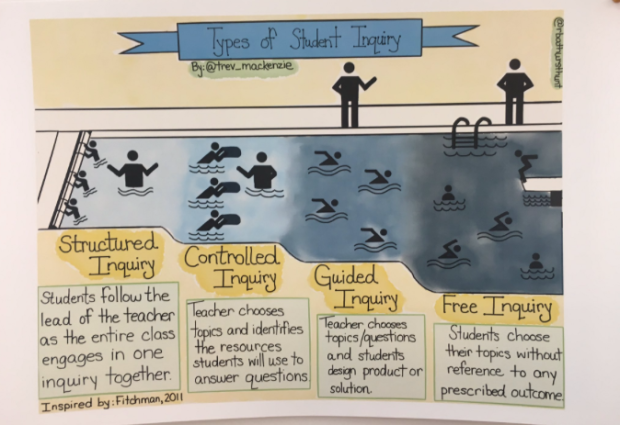
We were shown examples of student learning that evolved from his Free Inquiry unit, and they were impressive. At first glance, some of the projects didn’t seem to have much to do with English literature; however, once Trevor explained that students all wrote a personal narrative essay along with handing in a final project, it was clear that his students were still meeting the learning standards, and in many cases, exceeding them. He shared inspiring stories of seemingly unengaged students who stepped up to the plate when they were allowed to pursue topics that they were passionate or curious about, or (in the case of students who haven’t yet discovered a passion) who were allowed to work toward a specific goal or challenge.
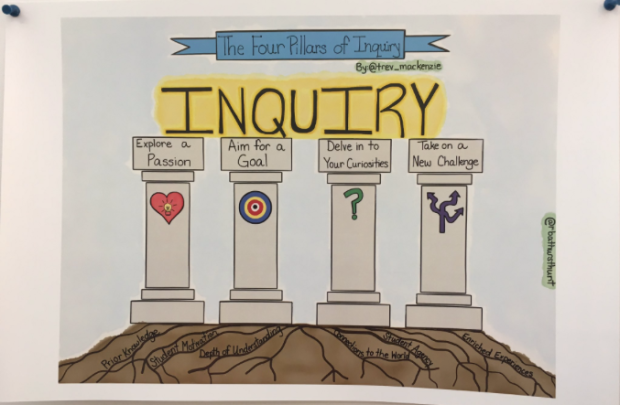
One thing that struck me about Trevor’s English class is how it so naturally became a cross-curricular environment. We know that not all students in English are going to become English majors, and that not all Science students will become Science majors, &c. Why, then, would we try to make our teaching subject “pure” in the sense that it doesn’t spill over to other subjects? Life is by its very nature cross-curricular. If a student wants to be a mechanic, shouldn’t we support that endeavour to some extent in every subject? By allowing students to pursue whatever they want in the Free Inquiry unit, they can tie English to other areas, thereby becoming more engaged with their assignment and producing work that is meaningful to them, often of a higher quality than an assigned piece.
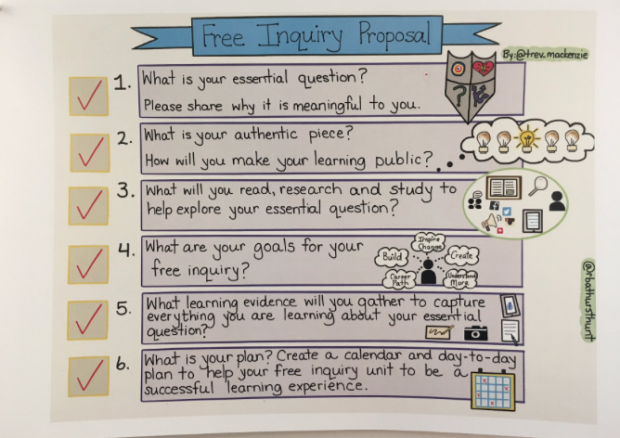
The graphic above is the project proposal that Trevor uses in the last quarter of the year. He goes over each proposal and discusses the assessment criteria with each student so they have a clear idea of what they are working towards. Near the end of the year, Trevor gives lots of free time for students to work on their project in class. If they are unable to complete work in class, he asks to see regular proof of learning (via video, blog, or another medium); as he pointed out to us, just because a student isn’t in class, doesn’t mean learning isn’t happening.
Students are engaging with a variety of literacies when they pursue their own topics: digital, inter- and intrapersonal, oral, physical, and more. Digital literacy in particular is something that Trevor takes time to discuss with his class, as it’s a huge part of today’s world. All of his students have blogs, and they discuss creating a professional online presence as well as networking and finding good sources (all of which are built into the above proposal graphic). The diversity of literacies is nicely on display in the final projects. To see examples of student work in his Free Inquiry model, visit Trevor’s blog.
Takeaways from Trevor MacKenzie’s Class:
(1) More freedom requires more support. Scaffold so that students aren’t thrown into the deep end of Inquiry. Model the approach as a class before gradually releasing responsibility, and always be there to help them.
(2) Develop relationships with your students. You can’t personalize learning if you don’t know your students as people. Figure out what they are interested in by assigning short writing assignments (e.g. “What are you passionate about?”), by conducting short interviews (e.g. “Where do you want to be in three years?” “What are your hobbies?”), or by bringing in resources that may spark curiosities. Then allow students to pursue those interests in their assessment pieces.
(3) Don’t limit your students to typical topics for your subject area. Allow them to ask questions about anything they are interested in, and if you are uncomfortable assessing a piece, involve professionals or other teachers in your school. Embrace the cross-curricular nature of student inquiry.
(4) Frontload the curricular learning objectives so students have time to pursue their own projects in Free Inquiry.
(5) Bring attention to the different skills and literacies that the students are engaging with at each step of the Inquiry process. Spend time discussing digital literacy and helping students navigate the internet in a professional way. Be willing to see certain skills manifest in unexpected ways (e.g. communication skills may be represented in video rather than an essay format).


